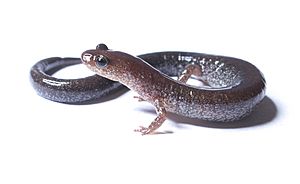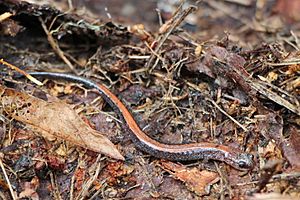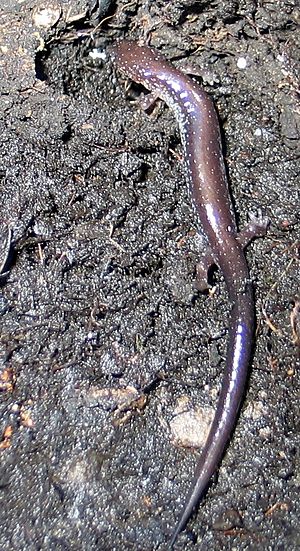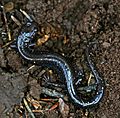Red-backed salamander facts for kids
Quick facts for kids Red-backed salamander |
|
|---|---|
 |
|
| "Leadback" phase | |
| Conservation status | |
| Scientific classification | |
| Synonyms | |
|
The red-backed salamander (Plethodon cinereus) is a small, tough woodland salamander. It belongs to a group called Plethodontidae. These salamanders live in forests across eastern North America. You can find them from Quebec in Canada down to North Carolina in the USA. They also live west to Missouri and Minnesota.
People sometimes call them the redback salamander or eastern red-backed salamander. This helps tell them apart from a similar species, the southern red-backed salamander (Plethodon serratus). The red-backed salamander is one of 56 types in the Plethodon group.
Contents
Meet the Red-Backed Salamander: Appearance and Habitat
The red-backed salamander is a small animal. It measures about 5.7 to 10.0 centimeters (2.2 to 3.9 inches) long, including its tail. These salamanders live on land in forests. They often hide under rocks, logs, bark, and other things on the ground. They are very common in the areas where they live.
These salamanders can have different colors. This is called polymorphism, meaning "many forms." Two main color types are common. The "red-backed" type has a red stripe down its back. This stripe gets thinner towards its tail. The other type is darker. It is called the "lead-backed" or "lead" phase. This type has little to no red color.
The red stripe is not always red. It can be yellow, orange, or even white. Sometimes, a rare type is completely red. Both color types have bellies that are speckled black and white. Other rare color types exist too. These include iridescent, albino, and melanistic forms.
Scientists found a special bacterium on the skin of red-backed salamanders. It is called Lysobacter gummosus. This bacterium makes a chemical that stops bad fungi from growing. These fungi can harm the salamanders.
Salamander Behavior: How They Act
Red-backed salamanders show different behaviors when a predator is near. This depends on their color. The lead-backed salamanders often try to run away. But the red-backed salamanders usually stay still. They might use warning coloration. This means their bright color tells predators they might be bad to eat.
Scientists studied their stress levels. They looked at cells in their blood. The lead-backed salamanders seemed more stressed than the red-backed ones. This might be because lead-backed salamanders face more danger from predators in the wild. It also means they might be more stressed if kept in captivity.
Like many salamanders in their group, Plethodon cinereus can find their way home. Females return to their nests. Other females and males also return to their home areas. This "homing" helps female salamanders protect their eggs. It also lets other salamanders explore for food or shelter. If they don't find a better spot, they can return to their safe home.
Reproduction and Life Cycle
Male and female red-backed salamanders usually set up their own areas. They use these spots for eating or mating. They often hide under rocks and logs. However, some red-backed salamanders might stay together as a pair. They may even defend their shared area.
Breeding happens in June and July. Females lay between four and 17 eggs each year. The eggs hatch after 6 to 8 weeks. Young salamanders, called neonates, tend to stay near where they were born. This is called philopatry.
These salamanders mainly eat small invertebrates. They also eat other tiny creatures found in decaying matter. In some good habitats, these salamanders are very common. There can be over 1,000 individuals in just one acre of land. That's a lot of salamanders!
Female red-backed salamanders can store sperm. This stored sperm is called spermatophore. They can keep it for up to eight months before laying eggs. They use this stored sperm to fertilize their eggs in June and July. After laying eggs, they do not keep the sperm anymore.
Images for kids





